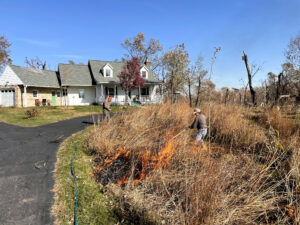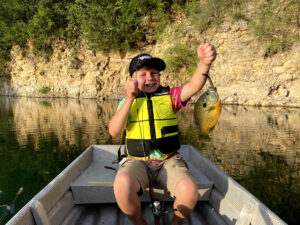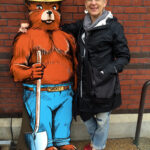by Winding Pathways | Aug 4, 2022 | Wonderment
Near our home is a frog statue that a neighbor decorates seasonally and for special occasions.
Here are some photos I have taken over the years.
-

-
COVID-19 Protection
-

-
Earth Day
-

-
Mother’s Day
-

-
Summer Fun
-

-
Derecho Clean Up
-

-
Fall Raking
-

-
Pomp and Circumstance
-

-
Fourth and Vandals (UIdaho)
-

-
Fall Football!
-

-
Vote – Intelligently!
by Marion Patterson | Dec 16, 2021 | Labyrinths, Reflections/Profiles, Wonderment
Where Did the 2020 Labyrinth Blog Go?
I’m curious what happened to the 2020 labyrinths blog! While I mainly walked the Phoenix Harmony Labyrinth in our yard, I know I walked other labyrinths. Edith Starr Chase’s lovely one at Wickiup Hill on a magical Winter Solstice evening. The comforting labyrinth at New Bo District. And, early in the season, the Westminster Presbyterian Church of Waterloo, IA, labyrinth. Well, it will show up. Meanwhile, here is a look back anyway.
I’ll just share again.
-

-
Teri blesses the labyrinth
-

-
Westminster Presbyterian Church in Waterloo, IA, has a lovely inlaid labyrinth.
-

-
Emie smudges the Phoenix Harmony Labyrinth December 31, 2020.
-

-
The last time I took a pix of the Three Guardian Firs before Derecho 2020
-

-
Each year we burn the labyrinth.
-

-
While bare, the ash prepares the soil for next year’s blooms.
-

-
Child at Center of Wickiup Hill Labyrinth
-

-
Walking the labyrinth with the solar lights in autumn is magical.
Now on to 2021!
-

-
March – A lovely labyrinth tucked into a corner of the seminary
-

-
Looking back.
-

-
April in Anchorage – Sometimes walking the path is enough.
-

-
March – This unusual labyrinth incorporated a tree in the middle.
-

-
March – Maintenance is always important with labyrinths.
-

-
September – A favorite labyrinth to visit.
-

-
May – Several people joined to take in the emerging plants.
-

-
July – Part of the Johnson County, Iowa, conservation commission, this labyirnth invites contemplation.
-

-
Fall – A child explores the labyrinth.
-

-
October – We explored ways to interact with the labyrinth.
-

-
The weekly finger labyrinth walks sponsored by Veriditas attract people from six continents.
-

-
November – The labyrinth is playful.
-

-
Edith Starr Chase sponsors lovely labyrinth walks.
-

-
October – I walked in the fall without snow.
-

-
November – P. Admires his work as the solar lights glow softly.
by Winding Pathways | Sep 16, 2021 | Nature, Reflections/Profiles, Wonderment
“It’s a monster!” Payton yelled out! His fishing pole, made for a child to catch tiny fish, bent in a 180-degree arch. Somehow, amazingly, he guided the monster close enough that I could grab its lower jaw. Seconds later it was in the boat.

A proud fisherman.
Wow! It was a monster. 5.1 pounds is a big Largemouth bass. After carefully removing the hook, we slid her back into the water. The fish finned away, yet the memory will linger for a lifetime.
We’ve known 10-year-old Payton and his family for several years. His parents don’t fish and they want him to develop a wide range of interests. I, Rich have fished for most of my 72 years and offered to take him to a local pond. That was in the spring. We’ve since floated in my tiny row pram several times.
Mentoring. I thought I’d teach him how to fish. I sort of succeeded. At least by these skills he’s learned:
- Casting with one hand.
- Fishing without getting many tangles…..and being able to untangle most of the ones he does get.
- Learning knot tying.
- Identifying fish species.
- Picking the right lure and gently handling and releasing fish.
- Spotting mink, kingfishers, turtles, and toads.
- Collecting data. We keep length and weight records of the fish we catch.
What I didn’t realize before we started fishing was what I’d learn, including the patience needed to untangle snarls of line. I also learned some new easy-to-tie knots so I could show Payton. And, we had the chance to talk about conservation as we got to know each other.

Payton has learned several skills.
Mentoring. It’s fun. Fishing has been our activity but an adult mentor can spark a kid’s interest in all sorts of activities, ranging from playing golf to fixing engines. It’s rewarding to share a hobby with a youngster…..and initiate a lifelong passion.
by Winding Pathways | Jul 22, 2021 | Nature, Wonderment
Winding Pathways borders 110-acre Faulkes Heritage Woods, a primeval woodland that changed dramatically in 40 minutes last August 10, 2020, when a derecho roared through Eastern Nebraska, all of Iowa and into Illinois.

A short walk through the woods brought us to Indian Creek.
Prior to the storm, the view from our back deck was of towering oaks, hickories, walnuts, and a few maples. We’d often walk a quarter-mile to Indian Creek under a nearly closed crown of intertwined branches far overhead.
Then a derecho roared through with 140-mile-an-hour winds. (Watch several videos of the storm)
When we ventured outside, we found two big trees on our garage and cabin, and most of our own trees prostrated. Our power and Internet were down. Our biggest shock was the woods. Instead of immense giants, we saw trees that had withstood 150 years of wind shattered. Some were uprooted. Many snapped off with their trunks standing like poles. Others were twisted apart by the powerful wind.
It was devastating. Heartbreaking. All winter our view was of broken trees………until spring’s warmth worked magic on the woods.
-

-
Faulkes Woods is still a tangle of jackstraw trees.
-

-
All winter we looked on broken trees.
-

-
Springing Back from Derecho.
Forests are resilient. For the first April in over a century sunlight reached the forest floor. As it gained strength in May and June it triggered a resurgence of vegetation we’d never seen in the woods before. All were plants that can’t thrive in dense shade.
We were overjoyed to see tree sprouts. Baby oaks, hackberries, ironwood, maple, and basswoods popped up here and there. Soon they were joined by a thick growth of what many would call weeds. A few are new to us, including oakleaf goosefoot. Some are concerning. The sunshine is encouraging invasive garlic mustard, multiflora rose, and Japanese barberry, but we also spotted something delicious.
Long dormant raspberry and blackberry canes rose from the soil. We’ll enjoy a great berry harvest next summer and for many following years until new trees gradually shade them to dormancy.
-

-
The seedling radiated hope.
-

-
Invasive plants take advantage of change.
-

-
Miracle in the rubble
Nature is resilient, and we’re watching a woodland resurrection from our back deck.
-

-
This sun lover is nestled close to the uprooted log.
-

-
Sun loving brambles surround fallen log.
Watch a video from 12th Ave. Bridge in Cedar Rapids.
by Winding Pathways | Mar 25, 2021 | Amphibians/Reptiles, Birds, Bugs, Nature, Trees, Wonderment
Quilting and the Chesapeake Bay
Guest Blogger, Sigrid Reynolds
I have always loved the humble arts of unknown women who pieced quilts. My own attempts at the craft had resulted in exactly 10 squares in the 1980s when I had small children at home who took afternoon naps. At the same time, I started looking through the piles of quilts at antique stores in the Shenandoah Valley. It thrilled me to see the patterns, colors, and precise stitching of women from the past. So seduced was I by these piles, I knew collecting could get out of control. But then I found a Pennsylvania Dutch unquilted top in an original bold tulip design of blue, red, and yellow colors. I decided to seek and purchase only this color combination. That kept the lid on it since these colors are rare in combination.
COVID-19 Quilting
Taking up quilting again didn’t occur to me until Spring 2020 when I was asked to join a young friend’s virtual pandemic quilt circle. In a time when we all faced our own mortality and the uncertain path the pandemic and the nation would take, we needed something to calm ourselves. As a retired person, I had nothing filling my time and frankly, felt the need to leave some little part of me behind in the lives of my descendants.
The group chose a striking geometric pattern with many triangular pieces. I purchased material, cut a few triangles, and then I went rogue. My inclination was to go faster, larger and more personal since I’d found piecing tedious in those earlier tries. Besides, I am 30 years older than the members in my group so my “life” time is more limited. I found purpose in a multi-generational family vacation home on the Chesapeake Bay just begging for Aunt Sig artifacts for posterity.
A “Fishy” Quilting Inspiration
My first quilt was a re-interpretation of a fish painting that the family had owned for 90 years. The family has always asked guests to tell them how many fish they see in the painting. So, I added goldfish for a humorous twist and quilted in additional fish. In all, there are 40 fish in this quilt.
-

-
A humorous adaptation of the family fish painting.
-

-
Remembering sunning turtles.
What came next was an urge to recognize the other birds and animals seen regularly on or near the Bay: herons in the morning and evening along with osprey all day. And then I was remembering sunning turtles in a nearby spring-fed pond. I added more goldfish and quilt fish to keep the puzzle going.
I next needed to represent the loblolly pines that line the shores of that estuary. And, of course, I needed additional visitors: raccoons, foxes, and box turtles. While quilting, I added one ghostly possum in the lower right-hand corner. And why not add some quilted poison ivy since that is always an island hazard? And yes, there are fish quilted into the water to count.
-

-
The beginnings of a personal quilt.
-

-
Capturing the sunrise
New Inspirations
Finally, as this quiet, worrisome time comes to an end, I realized that I needed to turn from nature to hail the Baltimore Light, a caisson lighthouse, that has defined the deep channel for ships going into Baltimore Harbor my entire life. Since it was winter, I recalled the two times that I had seen the Bay had frozen and decided that might be a good subject. And yes, there will be quilted fish to count under the ice floes.
Nature Continues to Inspire
I have pondered what prompts this late-in-life creativity and conclude that the pandemic opened up a fertile field in me that might have remained fallow. I, like many, turned to the nearby nature of our backyard and parks but memories of a barefoot childhood on the Bay persisted. Quilting allowed me to visit the nature of my memories.


by Winding Pathways | Apr 23, 2020 | Mammals, Nature, Reflections/Profiles, Uncategorized, Wonderment
A few months ago, we posted a blog honoring Smokey Bear on his 75th birthday. Smokey was created by the United States Forest Service in an effort to encourage people to be careful with fire. His was one of the most successful marketing campaigns in history.

The allure of Smokey Bear.
Smokey is adorable yet commanding. When he said to drown campfires and snuff out cigarettes you did it without question. Today, we know that forest fires are a natural phenomenon with beneficial ecological impacts, but Smokey’s message still resonates.
Two Winding Pathways readers shared their memories of Smokey Bear.
Tracy McPartland of Cedar Rapids sent us a photo of her with Smokey taken at the Smithsonian. “I loved Smokey Bear as a kid. I used to voice imitate him even though I don’t know what his voice was like.”

Smokey has been well-loved.
Jim Rainey is a retired US Army LTC who lives in Pennsylvania. Recently, he told us he received a Smokey doll from Santa in the early 1950s when he was four or five years old. “I was enchanted by Smokey. And, my doll still sits on the chair in my office. Sometimes my dog uses him as a pillow. At age 65, or so, he has patches on his jeans, is missing some hair, and part of his nose is gone. A few years ago, we asked our three daughters what they wanted of our stuff and was surprised when our oldest daughter said she wanted Smokey. Before then I was thinking of having him put in my casket, but I really didn’t want him locked in a box for eternity. I’ll let my daughter enjoy him and think of me,” he said.
Rich also has pleasant memories of Smokey and passed his image whenever he entered the Boise, Clearwater, or Idaho Panhandle National Forests during his college years. In 1974 he was a US Forest Service Hot Shot and fought three wildfires in Idaho. He’s kept a Smokey poster on his office wall for years.
There is confusion. Technically he’s Smokey Bear, not Smokey THE Bear.
A former college contact, the Fazio Family, owns Woodland Catalog Smokey Bear Gifts and has a store in Moscow, Idaho. Anyone wanting Smokey items can order it online. There’s a Smokey Bear museum in a state park in Capitan, New Mexico. You can take a brief virtual tour at
Smokey endures for the ages. His message is clear, and his presence is endearing.


















































